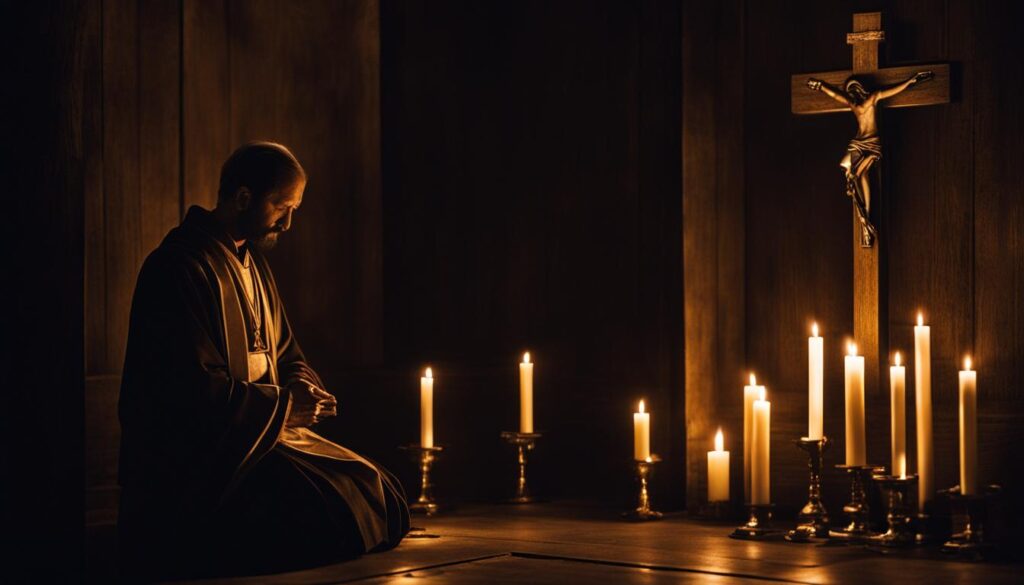In the Catholic Church, prayer is an integral part of our spiritual journey. Through traditional Catholic prayer practices, we seek to deepen our connection with God, find solace in His presence, and cultivate a life of faith and devotion. These practices, rooted in centuries of Catholic tradition, provide us with guidance and structure as we explore the richness of our faith.
Traditional Catholic prayers encompass a variety of methods that lead us towards a contemplative relationship with God. From the timeless devotion of the rosary to the reflective meditation of lectio divina, these prayer practices offer us different ways to engage with our faith and nurture our spiritual lives.
Key Takeaways
- Traditional Catholic prayer practices guide us in deepening our relationship with God.
- Lectio divina, composition of place, poustinia, the saint method, the examen, the liturgical method, and the rosary are popular traditional Catholic prayer methods.
- Mental prayer methods are essential for contemplation and fostering a deeper connection with God.
- Choosing a prayer method that resonates with us is important for spiritual growth.
- Traditional Catholic prayer practices offer a rich spiritual experience and help us encounter the living God.
The Importance of Prayer Methods in Catholic Tradition
Prayer methods play a crucial role in Catholic tradition as they provide structure and guidance for our conversations with God. The Catechism of the Catholic Church emphasizes the importance of regular meditation and encourages Christians to explore various prayer methods that suit their specific needs and circumstances.
“Prayer is the life of the new heart. It ought to animate us at every moment. But we tend to forget him who is our life and our all. This is why the Fathers of the spiritual life in the Deuteronomic and prophetic traditions insist that prayer is a remembrance of God often awakened by the memory of the heart: “We must remember God more often than we draw breath.” But we cannot pray “at all times” if we do not pray at specific times, consciously willing it.” ~ Catechism of the Catholic Church
It’s essential to approach prayer methods with discernment, considering factors such as our temperament, state-of-affairs, and personal preferences. While prayer methods are there to assist us, they should not be seen as rigid rules but as helpful tools on our spiritual journey towards deeper union with God.
Choosing the Right Prayer Method
When exploring Catholic prayer traditions, it’s important to choose the prayer method that resonates with your spiritual needs and helps you connect with God on a deeper level. Some individuals find solace in contemplative practices such as centering prayer or the Ignatian Examen, while others may prefer the structure and rhythm of the Liturgy of the Hours. There is no one-size-fits-all approach to prayer, and each person’s journey is unique.
Remember that the goal of prayer is to foster a deeper relationship with God, so it’s important to listen to your heart and allow the Holy Spirit to guide you in your prayer practice. Don’t be afraid to try different methods and explore various prayer resources to find what works best for you.

By incorporating prayer methods into your daily life, you can cultivate a deeper sense of faith, draw closer to God, and experience the transformative power of prayer.
Understanding Contemplation and Meditation in Catholic Prayer
Contemplation is the ultimate goal of prayer, where the soul experiences a close intimacy with God. It is a gift from God that allows us to deepen our faith and be grounded in love. Meditation, on the other hand, is the work we do to prepare ourselves for contemplation. It involves using prayer methods to enter into a state of mental prayer and engage in conversation with God.
Contemplation and meditation are central to Catholic prayer rituals, and while the methods may vary, they all serve the purpose of helping us encounter the living God and foster a deeper relationship with Him. Through contemplation and meditation, we open ourselves to receive divine wisdom and guidance, allowing God’s love to transform our hearts and minds. These practices invite us to trust in God’s presence and surrender our will to His divine plan.
“Contemplation is a form of prayer in which the divine gaze of the Father, in which we are always immersed, comes to rest lovingly on us, embracing us in our entirety.” – Pope Francis
In the Catholic tradition, there are various devotional prayers and techniques that aid in quieting the mind and entering into a state of deep contemplation. Some examples include focusing on sacred images, reciting sacred words or mantras, and engaging in repetitive prayer or mantra. These practices allow us to let go of worldly distractions and center ourselves in God’s presence.
Finding Stillness in Prayer
To experience the transformative power of contemplation and meditation, it is essential to create an environment conducive to prayer. Find a quiet space where you can be alone with God, free from distractions. Choose a comfortable sitting position that promotes relaxation and focus. Close your eyes, take deep breaths, and consciously let go of the busyness of life.
As you begin your prayer, focus your attention on God’s presence within you. Invite the Holy Spirit to guide your thoughts and open your heart to receive God’s love. Allow yourself to rest in God’s presence, surrendering all anxieties and concerns. Embrace the stillness and silence, knowing that it is in these moments that God speaks to our hearts.

Embracing Silence and Listening
During contemplation and meditation, it is vital to listen attentively to God’s voice. Embrace the silence as a space for God to speak to your heart. Be receptive to any thoughts, feelings, or promptings that arise. The Holy Spirit may offer guidance, wisdom, or consolation through the gentle whisper of your soul.
Remember, prayer is not solely about speaking to God; it is also about listening. Allow God to reveal Himself to you in the quiet moments of prayer. As you grow in your practice of contemplation and meditation, you will develop a deeper sensitivity to God’s presence and a heightened ability to discern His voice.
Prayers of Gratitude and Surrender
As you conclude your time of contemplation and meditation, offer prayers of gratitude for God’s presence and the blessings in your life. Express your love and thanksgiving for the gift of prayer and the opportunity to commune with the Divine. Surrender your will to God’s loving guidance, trusting that He knows what is best for you.
Let your prayer be a continuous conversation with God, extending beyond the moments of contemplation and meditation. Seek to carry the stillness and peace you experience during prayer into your daily life, inviting God to guide your thoughts, words, and actions.
Inspired Quotes
“Meditate upon the mysteries of the Holy Rosary in order to nourish contemplation, which is the source of true and constant dialogue with God.” – Pope Saint John Paul II
Exploring Traditional Catholic Prayer Methods
Traditional Catholic prayer methods offer a variety of ways to connect with God. These prayer practices have been passed down through generations and are deeply rooted in the rich spiritual traditions of the Catholic Church. By engaging in these time-honored methods, individuals can deepen their relationship with God and cultivate a more profound sense of spirituality. Let’s explore some of these traditional Catholic prayer methods:
Liturgy of the Hours
The Liturgy of the Hours, also known as the Divine Office, is a structured prayer that is prayed throughout the day by priests and religious. It consists of psalms, hymns, and other sacred texts, and is considered the official prayer of the Church. However, this prayer is not limited to clergy and religious; laypeople can also adapt it to fit their schedules and participate in this beautiful prayer tradition.
Lectio Divina
Lectio divina, meaning “divine reading” in Latin, involves prayerful reading and contemplation of Scripture passages. It is a method that invites individuals to listen attentively to God’s word and allow it to penetrate their hearts. In this prayer practice, one reads a passage of Scripture, meditates on its meaning, prays with it, and then rests in God’s presence, allowing Him to speak to the innermost depths of the soul.
Centering Prayer
Centering prayer is a method of silent prayer that focuses on resting in God’s presence and consenting to His action within. It involves choosing a sacred word or phrase, such as “Jesus” or “Abba,” and repeating it silently as a means to center and quiet the mind. Through this prayer, individuals seek to let go of distractions and thoughts, and surrender themselves entirely to God’s loving presence.
Ignatian Contemplation
Ignatian contemplation is a prayer method developed by St. Ignatius of Loyola, the founder of the Society of Jesus (Jesuits). It is a form of imaginative prayer that encourages individuals to place themselves within a biblical scene and engage their senses in experiencing the presence of God. This prayer method helps individuals deepen their understanding of Scripture and fosters a more intimate encounter with God.
Ignatian Examen
The Ignatian Examen is a prayer method that involves reflecting on one’s day and seeking to find God’s presence in the events and experiences of daily life. It follows a structured process of reviewing the day, expressing gratitude, examining moments of consolation and desolation, seeking forgiveness, and making resolutions for the future. The Examen helps individuals develop a greater awareness of God’s work and presence in their lives.
The Rosary
The Rosary is a beloved and widely practiced devotional prayer in the Catholic tradition. It involves the recitation of prayers and meditation on the life, death, and resurrection of Jesus, as well as the intercession of the Blessed Virgin Mary. The Rosary is typically prayed using a set of beads, and each bead represents a specific prayer. This prayer method encourages individuals to contemplate the mysteries of the faith and seek Mary’s intercession in their lives.
The traditional Catholic prayer methods mentioned above are just a few examples of the diverse prayer practices that Catholics can incorporate into their spiritual journey. Each method has its own unique approach and offers a different way to connect with God. By exploring these traditional prayer methods, individuals can find the one that resonates with them and brings them closer to God.
| Prayer Method | Description |
|---|---|
| Liturgy of the Hours | Structured prayer prayed throughout the day by priests, religious, and laity. |
| Lectio Divina | Prayerful reading and contemplation of Scripture passages. |
| Centering Prayer | A method of silent prayer that focuses on resting in God’s presence. |
| Ignatian Contemplation | Imaginative prayer that places individuals in a biblical scene to encounter God. |
| Ignatian Examen | Reflective prayer method that helps individuals find God’s presence in daily life. |
| The Rosary | Devotional prayer focused on the life of Jesus and the intercession of Mary. |

Prayer as a Conversation with God
Prayer is fundamentally a conversation with God, a way to build and nurture our relationship with Him. It is more than just asking for things; it is a means of seeking union with God and receiving His unconditional love. Just as in any relationship, prayer involves both speaking and listening.
While there are no strict formulas for prayer, the Catholic Church provides traditional prayers such as the Our Father and the Hail Mary to guide and express our intentions. These ancient prayers have been passed down through generations of faithful Catholics, serving as a foundation and guide in our communication with God. When we recite these prayers, we join in the chorus of believers who have uttered these sacred words throughout history.
“Our Father, who art in heaven, hallowed be thy Name, thy kingdom come, thy will be done, on earth as it is in heaven. Give us this day our daily bread. And forgive us our trespasses, as we forgive those who trespass against us. And lead us not into temptation, but deliver us from evil. Amen.”
“Hail Mary, full of grace, the Lord is with thee. Blessed art thou among women, and blessed is the fruit of thy womb, Jesus. Holy Mary, Mother of God, pray for us sinners, now and at the hour of our death. Amen.”
However, it is essential to approach prayer with an open mind and heart, allowing God to speak to us and embracing the freedom to express our deepest desires and concerns. Prayer is a personal and intimate experience, where we can pour out our hearts to God and share our joys, sorrows, hopes, and fears.
Just as we speak to God through prayer, we must also take the time to listen. Prayer is not only about expressing our own needs and desires but also about cultivating a receptive heart to hear God’s voice. Through silence, reflection, and meditation, we create space for God to speak to us, guiding us, comforting us, and revealing His will for our lives.
Whether it is through formal prayers, spontaneous words, or moments of contemplative silence, prayer is an ongoing conversation with God. It is an opportunity to deepen our faith, cultivate spiritual growth, and strengthen our relationship with the Divine.
Image:

Tips for Effective Prayer
Prayer is a sacred act of communication with God, and creating a conducive environment can enhance our prayer experience. Here are some tips to make the most of your prayer time:
- Find a quiet space: Taking a few moments to quiet down and find a comfortable, distraction-free space can help you focus your mind and heart on prayer.
- Be present in the moment: Allow yourself to be fully present during prayer, setting aside any worries or distractions. Embrace the stillness and open yourself up to receive God’s presence.
- Let go of rigid structures: Remember that prayer can take various forms and does not need to follow a strict structure. Whether it’s a brief moment of reflection or a longer period of contemplation, what matters is the sincerity and openness of your heart.
- Embrace your surroundings: While an ideal setting is not always possible, remember that God meets you where you are. Even in the midst of a busy day or in less-than-ideal circumstances, your prayers are welcomed and heard.
- Engage in conversation with God: Prayer is a two-way communication, so make sure to speak and listen. Share your thoughts, desires, and concerns with God, but also take time to be still and listen for His gentle voice.
“Prayer is not asking. It is a longing of the soul.” – Mahatma Gandhi
Remember, prayer is a personal and intimate experience, and each person’s journey with God is unique. By creating a tranquil environment and approaching prayer with a sincere and open heart, you can deepen your connection with God and experience the transformative power of prayer.

The Significance of the Eucharist in Catholic Prayer
Eucharistic Adoration holds a significant place in Catholic prayer. It involves focusing on the real presence of Jesus in the Eucharist and engaging in direct prayer and worship. Adoring Jesus in the Blessed Sacrament helps us deepen our understanding of the Mass and reminds us of the profound love God has for us. The Eucharist allows us to experience God’s presence not only in our spirits but in a tangible way that engages our senses. It is a sacred space where we can pray, listen, and be in the presence of God.
The Transformative Power of Prayer
Prayer has the power to transform our lives and bring us closer to God. Through prayer, we open ourselves to God’s guidance, healing, and grace. It helps us cultivate a deeper sense of gratitude, trust, and surrender to God’s plan for our lives. Regular prayer practice enhances our spirituality and nurtures our faith, allowing us to live more intentionally and purposefully.
The journey of prayer is unique for each individual, and exploring different prayer methods can help us discover what resonates with us and brings us closer to God.
When we engage in prayer, we enter into communion with the divine, experiencing a profound connection that transcends the physical world. Prayer allows us to communicate our joys, sorrows, hopes, and fears to a loving and compassionate God who listens and responds. It is a sacred space where we can pour out our hearts and feel the presence of a higher power.
One of the transformative aspects of prayer is its ability to nurture gratitude within us. As we lift our voices in thanksgiving and appreciation, we become more attuned to the blessings and abundance that surround us. Prayer reframes our perspective, helping us shift our focus from what we lack to what we have, fostering a sense of contentment and fulfillment.
Moreover, prayer strengthens our trust in God’s guidance and wisdom. It reminds us that we do not have to carry the burdens of life alone but can surrender them to a loving and all-knowing God who walks beside us every step of the way. In times of uncertainty, prayer provides solace and reassurance, allowing us to find peace amidst the storms of life.
“Prayer is not asking. It is a longing of the soul. It is daily admission of one’s weakness. It is better in prayer to have a heart without words than words without a heart.”
Through prayer, we open ourselves to the transformative power of God’s grace. It softens our hearts, shapes our character, and molds us into instruments of love and compassion. As we seek divine guidance through prayer, we become more aligned with God’s will and experience a sense of purpose and fulfillment.
“Prayer is not asking. It is a longing of the soul. It is daily admission of one’s weakness. It is better in prayer to have a heart without words than words without a heart.” – Mahatma Gandhi
| Benefits of Prayer | Effects |
|---|---|
| Strengthens our relationship with God | Deepens our spirituality and faith |
| Brings us peace and serenity | Reduces stress and anxiety |
| Fosters gratitude and contentment | Increases happiness and fulfillment |
| Guides us in making wise decisions | Provides clarity and discernment |
| Opens our hearts to love and compassion | Transforms our relationships with others |
Prayer is a gift that allows us to connect with the divine and experience transformative effects in our lives. It is a practice that brings us closer to God, strengthens our spirituality, and nourishes our souls. By embracing prayer as a regular part of our lives and exploring different prayer methods, we can tap into its transformative power and cultivate a deeper relationship with God.
Conclusion
Traditional Catholic prayer practices offer a beautiful and profound way to deepen our relationship with God. Through the structured prayers of the Liturgy of the Hours, the meditative approach of lectio divina, and the contemplative experiences of Eucharistic Adoration, we are guided to enter into a more meaningful conversation with our Creator.
By immersing ourselves in these prayer rituals, we have the opportunity to experience transformative moments in our spiritual journey. The devotional prayers and traditions of the Catholic Church provide solace, guidance, and a sense of connection to the divine.
As we engage in these traditional Catholic prayer practices, we open ourselves to growth, transformation, and deepening of faith. Through devotional prayers and rituals, we can find comfort in times of adversity, experience the joy of communion with God, and be inspired to live more intentionally in accordance with His will. May these timeless prayer practices continue to nourish our souls and guide us in our pursuit of a closer relationship with God.
FAQ
What are some popular traditional Catholic prayer methods?
Some popular traditional Catholic prayer methods include lectio divina, composition of place, poustinia, the saint method, the examen, the liturgical method, and the rosary.
How do prayer methods contribute to Catholic tradition?
Prayer methods in Catholic tradition provide structure and guidance for conversations with God, deepening the individual’s relationship with Him.
What is the goal of prayer in Catholic tradition?
The goal of prayer in Catholic tradition is contemplation – a close intimacy with God that deepens faith and fosters love.
What are some traditional Catholic prayer methods to deepen one’s relationship with God?
Traditional Catholic prayer methods include the Liturgy of the Hours, lectio divina, centering prayer, Ignatian contemplation, and the Rosary.
How is prayer described in Catholic tradition?
Prayer in Catholic tradition is fundamentally seen as a conversation with God, seeking union with Him and receiving His love.
How can individuals create an effective prayer experience?
Individuals can create an effective prayer experience by finding a quiet and comfortable space, being present in the moment, and approaching prayer with sincerity and openness.
What is the significance of Eucharistic Adoration in Catholic prayer?
Eucharistic Adoration focuses on the real presence of Jesus in the Eucharist, allowing individuals to engage in direct prayer and worship.
How does prayer transform lives in Catholic tradition?
Prayer has the power to transform lives by opening individuals to God’s guidance, healing, and grace, nurturing gratitude, trust, and surrender to God’s plan.
How do traditional Catholic prayer practices enhance spirituality?
Traditional Catholic prayer practices provide a diverse range of methods to nurture relationships with God, fostering transformation, faith, solace, and guidance.








